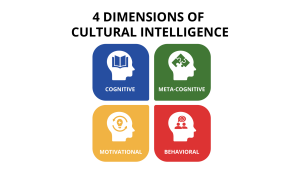27 Steps to Overcome International Communication Problem
NOR AZMA BINTI RAHLIN
Co-Authors: Lim Li Xin BB21110617, Lim Ziaojune BB21110200, Ou Ke Ying BB21110601, Ruth Maureen Loh Xhin Ying BB21110058, Sherry Yong Jing Ru BB21110122, Tan Pei Hui BB21110715
“Understanding communication for the workplace” by Study Work Grow is licensed under CC BY-SA 4.0
Steps 1 : Understanding and respecting cultural differences
 “Cross-Cultural Training through Education and Personal Experience: Low and High Rigor” by Laura Radtke is licensed under CC BY-SA 4.0
“Cross-Cultural Training through Education and Personal Experience: Low and High Rigor” by Laura Radtke is licensed under CC BY-SA 4.0
All communication is intercultural. Successfully communicating across cultures requires understanding and respecting how the culture or cultures you represent differ from those of the people you’re communicating with. While you may think that you should just follow the golden rule and treat everyone else the way you would like to be treated yourself, the more you travel to distant lands, the more you realize that cultural conventions and expectations for how people would like to be treated are relative. One culture will place a high value on a friendly handshake and eye contact, while you would come off as aggressive or awkward if you did those things well in another. While we may be members of many different cultures, we tend to identify with some more than others.
Though you can’t be expected to know every little custom across the planet, having a general sense of large-scale cultural differences and a willingness to learn the details as necessary can save you from embarrassing yourself or offending people of different cultures when interacting with them. An open approach to cultural differences can also impress your audiences in ways favourable to your reputation and the organization you represent. With these goals in mind, let’s consider the following dimensions of cultural difference from the perspective of social anthropology. In other hand, if you’re ethnocentric in the sense of being fearful, intolerant, or even just avoidant towards those other cultures—be they on the other side of the planet, country, province, city, building, counter, or desk—you limit your opportunities for success in the globalized market. Even engaging other cultures with simplistic, preconceived notions informed by media stereotypes reducing everyone in a culture to a one-dimensional character or prop will similarly lead you into serious error. As such, If your work brings you into contact with cultures that you know little about, forget the stereotypes and learn about their culture by both researching it and talking to them respectfully.
Sourced adopted from “Unit 49: Intercultural Communication” by Jordon Smith is licensed under CC BY-SA 4.0
Steps 2 – Meet your global colleagues in person
In today’s workplace, our colleagues may not be located in the same office, city, or even country. A growing number of tech companies have a global workforce of employees with varied experiences and perspectives. This diversity allows companies to compete in the rapidly evolving technological environment. Communication can deteriorate, misunderstandings can happen, and teams may stop trusting each other—all of which can affect the success of the company.For example, Americans communicating with Japanese colleagues, for example, should pay attention to the non-verbal cues, while Japanese communicating with Americans should prepare for more direct language. The best way to build long-lasting relationships is to meet your team members in person. If your company can afford it, arrange for this to happen. Meeting colleagues with whom you have been working will likely strengthen your relationship with them. The companies I have worked for have a strong record of periodically sending US team members to other countries and global colleagues to the US office.
Another way to bring teams together is to attend conferences. This not only creates educational and training opportunities, but you can also carve out some in-person team time.
In today’s increasingly global economy, it is becoming more important for companies to maintain a geographically diverse workforce to remain competitive. Although global teams can face communication challenges, it is possible to maintain a high-performing development team despite geographical and cultural differences. Share some of the techniques you use in the comments.
Sourced adopted from “Think global: How to overcome cultural communication challenges” by Avindra Fernando is licensed under CC BY-SA 3.0
Steps 3- Cross-Cultural Training through Education and Personal Experience: Low and High Rigor
Current research suggests that cross-cultural training can influence cultural intelligence. At a basic level, you can acquire cultural intelligence by taking classes in your program. Research has shown that taking cross-cultural management courses can enhance cultural intelligence (Ramsey et al., 2013).
For example, in a study of 152 MBA students, researchers found that the cultural intelligence of the students increased after they took a cross-cultural management course. In another longitudinal study, researchers found that studying abroad has a significant impact on the cognitive and metacognitive aspects of cultural intelligence. How do multinationals approach cross-cultural training? The above provides examples of low-rigor training, in which individuals are exposed to critical information to help them understand the realities of a different culture but are not actively and directly engaged with the culture (Lenartowicz et al., 2014). In such cases, instructors transfer basic information and knowledge to students through lectures, books, and case studies.
Companies can also rely on high-rigor methods of training, in which participants are actively engaged in the process and can learn some tacit aspects of cross-cultural differences (Lenartowicz et al., 2014). Examples of high-rigor training include classroom language training, case studies, and sensitivity training. High-rigor training also includes more experiential approaches such as role-playing, simulations, and field experiences. Some MNCs (multi-national corporations) also offer on-the-job training, during which employees are coached and trained while working at their jobs. This method allows the trainee not only to see a new culture but also to learn how that culture interacts with the work environment. The advantage of this method is that it enables the participant to be much more actively engaged in learning, thereby facilitating the transfer of knowledge. But as you might have guessed, high-rigor training is much more expensive to provide.
Which method works best? Experts agree that it depends on the nature of the assignment. Longer and more complex international assignments benefit from higher-rigor training (Lenartowicz et al., 2014). Furthermore, because international work assignments tend to be more short-term in nature, ways to enhance the metacognitive aspects of cultural intelligence are necessary (Mor et al., 2013). Today, because more leaders tend to have more frequent but shorter assignments to international companies, having metacognitive skills is critical. As a result, brief lectures or other low-rigor methods that simply provide information may be useful in helping develop the cognitive aspect but not metacognition. In such cases, high-rigor methods that allow participants to be much more actively engaged with culture will work well.
Sourced adopted from “Cross-Cultural Training through Education and Personal Experience: Low and High Rigor” by Laura Radtke is licensed under CC BY-SA 4.0
Steps 4: Recognise the Cultural Characteristics
Individualistic versus Collectivist Cultures
The Dutch researcher Geert Hofstede explored the concepts of individualism and collectivism across diverse cultures (Hofstede, 2005). He found that in individualistic cultures like the United States and Canada, people value individual freedom and personal independence, and perceive their world primarily from their own viewpoint. They perceive themselves as empowered individuals, capable of making their own decisions, and able to make an impact on their own lives.
Cultural viewpoints are not restricted to either/or dichotomies but are rather distributed across a continuum or range. You may belong to some communities that express individualistic cultural values, while others place the focus on a collective viewpoint. Collectivist cultures (Hofstede, 1982), including many in Asia and South America, focus on the needs of the nation, community, family, or group of workers. Ownership and private property is one way to examine this difference. In some cultures, property is almost exclusively private, while others tend toward community ownership. The collectively owned resource returns benefits to the community. Water, for example, has long been viewed as a community resource, much like air, but that has been changing as businesses and organizations have purchased water rights and gained control over resources. How does someone raised in a culture that emphasizes the community interact with someone raised in a primarily individualistic culture? How could tensions be expressed and how might interactions be influenced by this point of divergence? In the following sections these viewpoints will be examined.
Uncertainty-Accepting Cultures versus Uncertainty-Rejecting Cultures
 “DIVERGENT CULTURAL CHARACTERISTICS” by Arley Cruthers is licensed under CC BY-SA 4.0
“DIVERGENT CULTURAL CHARACTERISTICS” by Arley Cruthers is licensed under CC BY-SA 4.0
When people meet each other for the first time, they often use what they have previously learned to understand their current context. People also do this to reduce uncertainty. Some cultures, such as the United States and Britain, are highly tolerant of uncertainty, while others go to great lengths to reduce the element of surprise. Cultures in the Arab world, for example, are high in uncertainty avoidance; they tend to be resistant to change and reluctant to take risks. Whereas a U.S. business negotiator might enthusiastically agree to try a new procedure, the Egyptian counterpart would likely refuse to get involved until all the details are worked out.
- There is a high level of uncertainty at first. As we get to know one another, our verbal communication increases and our uncertainty begins to decrease.
- Following verbal communication, nonverbal communication increases, uncertainty continues to decrease, and more nonverbal displays of affiliation, like nodding one’s head to indicate agreement, will start to be expressed.
- When experiencing high levels of uncertainty, we tend to increase our information-seeking behavior, perhaps asking questions to gain more insight. As our understanding increases, uncertainty decreases, as does the information-seeking behavior.
- When experiencing high levels of uncertainty, the communication interaction is not as personal or intimate. As uncertainty is reduced, intimacy increases.
- When experiencing high levels of uncertainty, communication will feature more reciprocity, or displays of respect. As uncertainty decreases, reciprocity may diminish.
- Differences between people increase uncertainty, while similarities decrease it.
- Higher levels of uncertainty are associated with a decrease in the indication of liking the other person, while reductions in uncertainty are associated with liking the other person more.
sourced adopted from “Recognise the Divergent cultural Characteristics “ by Melissa Ashman is licensed under CC BY-SA 4.0
Steps 5: Ensure that every team member gets an opportunity to share their thoughts and ideas
Although I prefer to conduct meetings using video conferencing, this is not always possible. If video conferencing is not a common practice at your workplace, it might take some effort to get everyone comfortable with the concept. Start by encouraging everyone to participate in audio meetings.
One of our remote team members, who frequently met with us in audio conferences, mentioned that she often wanted to share ideas and contribute to the meeting but since we couldn’t see her and she couldn’t see us, she had no idea when to start speaking. If you are using audio conferencing, one way to mitigate this is to ensure that every team member gets an opportunity to share their ideas.

“STATE OF THE COMMONS 2022” by Pietro Soldi is licensed under CC BY-SA 4.0
Become an engaged listener
People often focus on what they should say, but effective communication is less about talking and more about listening. Listening well means not just understanding the words or the information being communicated, but also understanding the emotions the speaker is trying to communicate.
There’s a big difference between engaged listening and simply hearing. When you really listen—when you’re engaged with what’s being said—you’ll hear the subtle intonations in someone’s voice that tell you how that person is feeling and the emotions they’re trying to communicate. When you’re an engaged listener, not only will you better understand the other person, you’ll also make that person feel heard and understood, which can help build a stronger, deeper connection between you.
By communicating in this way, you’ll also experience a process that lowers stress and supports physical and emotional well-being. If the person you’re talking to is calm, for example, listening in an engaged way will help to calm you, too. Similarly, if the person is agitated, you can help calm them by listening in an attentive way and making the person feel understood.
Focus fully on the speaker, his or her body language, tone of voice, and other nonverbal cues. Tone of voice conveys emotion, so if you’re thinking about other things, checking text messages or doodling, you’re almost certain to miss the nonverbal cues and the emotional content behind the words being spoken. And if the person talking is similarly distracted, you’ll be able to quickly pick up on it. If you find it hard to concentrate on some speakers, try repeating their words over in your head—it’ll reinforce their message and help you stay focused.
Favor your right ear. The left side of the brain contains the primary processing centers for both speech comprehension and emotions. Since the left side of the brain is connected to the right side of the body, favoring your right ear can help you better detect the emotional nuances of what someone is saying. Try keeping your posture straight, your chin down, and tilting your right ear towards the speaker—this will make it easier to pick up on the higher frequencies of human speech that contain the emotional content of what’s being said.
Avoid interrupting or trying to redirect the conversation to your concerns, by saying something like, “If you think that’s bad, let me tell you what happened to me.” Listening is not the same as waiting for your turn to talk. You can’t concentrate on what someone’s saying if you’re forming what you’re going to say next. Often, the speaker can read your facial expressions and know that your mind’s elsewhere.
Show your interest in what’s being said. Nod occasionally, smile at the person, and make sure your posture is open and inviting. Encourage the speaker to continue with small verbal comments like “yes” or “uh huh.”
Try to set aside judgment. In order to communicate effectively with someone, you don’t have to like them or agree with their ideas, values, or opinions. However, you do need to set aside your judgment and withhold blame and criticism in order to fully understand a person. The most difficult communication, when successfully executed, can lead to the most unlikely and profound connection with someone.
Provide feedback. If there seems to be a disconnect, reflect what has been said by paraphrasing. “What I’m hearing is,” or “Sounds like you are saying,” are great ways to reflect back. Don’t simply repeat what the speaker has said verbatim, though—you’ll sound insincere or unintelligent. Instead, express what the speaker’s words mean to you. Ask questions to clarify certain points: “What do you mean when you say…” or “Is this what you mean?”
Hear the emotion behind the words by exercising your middle ear muscles by increasing the muscle tone of the tiny middle ear muscles (the smallest in the body), you’ll be able to detect the higher frequencies of human speech that impart emotion and be better able to understand what others are really saying. As well as by focusing fully on what someone is saying, you can exercise these tiny muscles by singing, playing a wind instrument, and listening to certain types of music (high-frequency Mozart violin concertos and symphonies, for example, rather than low-frequency rock or rap music).
Sourced adopted from“The Process of Communication” by Allen Urich is licensed under CC BY-SA 4.0

